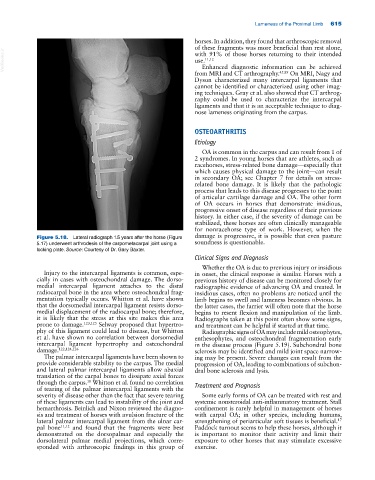Page 649 - Adams and Stashak's Lameness in Horses, 7th Edition
P. 649
Lameness of the Proximal Limb 615
horses. In addition, they found that arthroscopic removal
of these fragments was more beneficial than rest alone,
VetBooks.ir use. 11,12
with 91% of those horses returning to their intended
Enhanced diagnostic information can be achieved
from MRI and CT arthrography. 45,89 On MRI, Nagy and
Dyson characterized many intercarpal ligaments that
cannot be identified or characterized using other imag-
ing techniques. Gray et al. also showed that CT arthrog-
raphy could be used to characterize the intercarpal
ligaments and that it is an acceptable technique to diag-
nose lameness originating from the carpus.
OSTEOARTHRITIS
Etiology
OA is common in the carpus and can result from 1 of
2 syndromes. In young horses that are athletes, such as
racehorses, stress‐related bone damage—especially that
which causes physical damage to the joint—can result
in secondary OA; see Chapter 7 for details on stress‐
related bone damage. It is likely that the pathologic
process that leads to this disease progresses to the point
of articular cartilage damage and OA. The other form
of OA occurs in horses that demonstrate insidious,
progressive onset of disease regardless of their previous
history. In either case, if the severity of damage can be
stabilized, these horses are often clinically manageable
for nonracehorse type of work. However, when the
Figure 5.18. Lateral radiograph 1.5 years after the horse (Figure damage is progressive, it is possible that even pasture
5.17) underwent arthrodesis of the carpometacarpal joint using a soundness is questionable.
locking plate. Source: Courtesy of Dr. Gary Baxter.
Clinical Signs and Diagnosis
Whether the OA is due to previous injury or insidious
Injury to the intercarpal ligaments is common, espe- in onset, the clinical response is similar. Horses with a
cially in cases with osteochondral damage. The dorso- previous history of disease can be monitored closely for
medial intercarpal ligament attaches to the distal radiographic evidence of advancing OA and treated. In
radiocarpal bone in the area where osteochondral frag- insidious cases, often no problems are noticed until the
mentation typically occurs. Whitton et al. have shown limb begins to swell and lameness becomes obvious. In
that the dorsomedial intercarpal ligament resists dorso- the latter cases, the farrier will often note that the horse
medial displacement of the radiocarpal bone; therefore, begins to resent flexion and manipulation of the limb.
it is likely that the stress at this site makes this area Radiographs taken at this point often show some signs,
prone to damage. 123,125 Selway proposed that hypertro- and treatment can be helpful if started at that time.
phy of this ligament could lead to disease, but Whitton Radiographic signs of OA may include mild osteophytes,
et al. have shown no correlation between dorsomedial enthesophytes, and osteochondral fragmentation early
intercarpal ligament hypertrophy and osteochondral in the disease process (Figure 5.19). Subchondral bone
damage. 122,124,126 sclerosis may be identified and mild joint space narrow-
The palmar intercarpal ligaments have been shown to ing may be present. Severe changes can result from the
provide considerable stability to the carpus. The medial progression of OA, leading to combinations of subchon-
and lateral palmar intercarpal ligaments allow abaxial dral bone sclerosis and lysis.
translation of the carpal bones to dissipate axial forces
through the carpus. Whitton et al. found no correlation
18
of tearing of the palmar intercarpal ligaments with the Treatment and Prognosis
severity of disease other than the fact that severe tearing Some early forms of OA can be treated with rest and
of these ligaments can lead to instability of the joint and systemic nonsteroidal anti‐inflammatory treatment. Stall
hemarthrosis. Beinlich and Nixon reviewed the diagno- confinement is rarely helpful in management of horses
sis and treatment of horses with avulsion fracture of the with carpal OA; in other species, including humans,
lateral palmar intercarpal ligament from the ulnar car- strengthening of periarticular soft tissues is beneficial.
17
pal bone 11,12 and found that the fragments were best Paddock turnout seems to help these horses, although it
demonstrated on the dorsopalmar and especially the is important to monitor their activity and limit their
dorsolateral palmar medial projections, which corre- exposure to other horses that may stimulate excessive
sponded with arthroscopic findings in this group of exercise.

